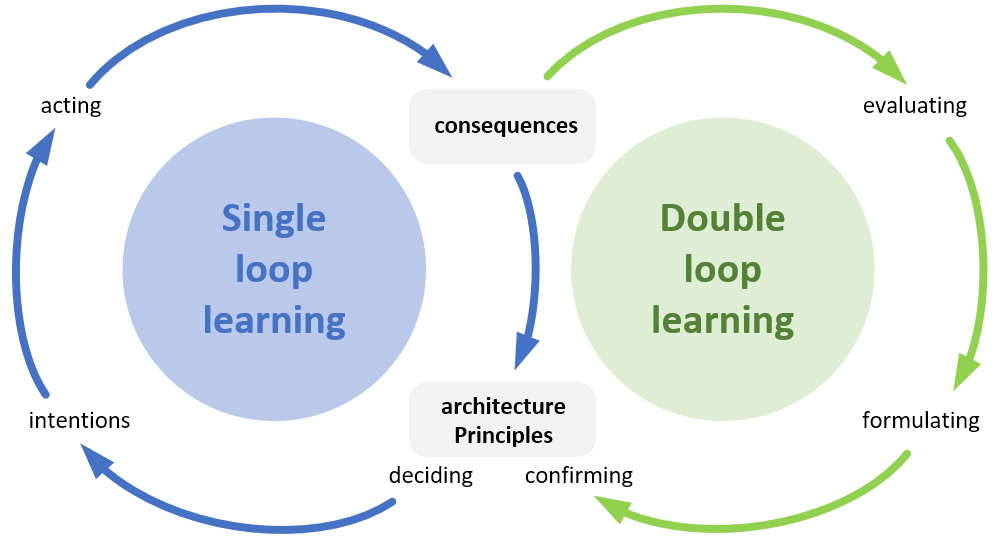FUNDAMENTALS FOR ARCHITECTURE PRINCIPLES (PART2)
January 4, 2023
In my previous blog, I described what architecture principles are and what they should consist of. With this basic understanding of what they are, how are they created and used?
Four phases in using architecture principles
We use architecture principles to steer and guide decision making by the organisations we support. Hence, as architects, we should be continuously evaluating our own decision making. Learning from our mistakes and gradually improving how to support better decision making and learning how to become a better advisor.
In the context of learning theory (Argyris and Schön, 1974) there are two types of learning:
- Single-loop learning
Analysing a problem, applying existing rules, planning and implementing changes. - Double-loop learning
Evaluating the consequences of your changes, improve your own rules
When these activities are mapped to our context and vocabulary, the four distinct phases in the life cycle of architecture principles are:
- Applying (deciding)
- Evaluating
- (re)Formulating
- Confirming
Applying principles is a form of single-loop learning. The phases evaluating (re)formulating, and confirming the architecture principles are part of double-loop learning.

Evaluating and formulating architecture principles
Formulating architecture principles is a creative process. It is often done by architects and considered part of double-loop organisational learning. They evaluate their own decision making, try to recognise a pattern and elevate this to a generic principle that would be applicable to a class of questions, and so guiding future decision making.
The same holds for evaluating and re-formulating existing principles.
A positive attribute of a formulation is its durability. But even after some years the formulations and applicability of any durable and stable principle should be evaluated and adjusted to an evolved environment.
Next to creating your own principles, existing examples are being selected and evaluated, re-used and applied in a different context. Because all these aspects are similar, I combine the evaluating and formulating activities in one phase.
Confirming architecture principles
The set of architecture principles is to be confirmed, preferably by the highest available authority within the organisation. The confirming of architecture principles is part of double-loop organisational learning too. The act of confirming give principles a formal status and increases their effectiveness to guide decision making. Especially when they are used as prescriptive rules.
From our experience we see a challenge when getting a confirmation by, for instance an enterprise board. The way of working and the consequences on the process of decision making is unknown by the board members. To get the approval of a board, the architects should explain how the application of the principles works.
A more generic set of principles could be seen as obvious statements that have no steering power. A more specific or technically detailed set of principles can be hard to understand by a not so tech-savvy board.
Compared to daily management decisions, giving approval for a set of principles, without understanding the consequences, is a tough decision that requires trust in the expertise of the architecture management.
A compromise found in organisations is the validation and confirmation of the principles by an architecture board. The members of this board should be sufficiently representing the relevant stakeholders in the enterprise and should have enough tech-savviness to understand the working and consequences of architecture principles. This board would then function as an authority in decision making and applying the architecture principles.
Applying architecture principles
Applying architecture principles is executed by architects and others involved in decision making. It is considered part of single-loop organisational learning.
As the architecture principles are formulated for a class of problems, applying a principle means the principle is to be interpreted. It is placed in the context of the decision to be made.
In the classic Dynamic Architecture (DYA) approach, this interpretation is done during the writing of a Project Start Architecture (PSA). In the context of sourcing, a Sourcing Start Architecture (SSA) guides any procurement decisions. There are several templates to be found to create these guiding documents. In a more agile world, architecture principles are applied during the evaluation of the backlog, when detailing an epic, or when preparing for the next sprint. In either case, the principles are applied when choices are to be made. Applied when architect provide their core-service, enabling good decision making.
Questions for you
An open question for me is about the frequency of the double-loop learning for architecture principles. How often is this loop executed explicitly? Should we make this an integral part of our architecture processes to regularly evaluate the effectiveness and efficacy of our principles?
About
This deep dive in the fundamentals of architecture principles is part of my explorative research with a goal to improve the quality of the principles and their life cycle processes, contributing to improving the organisations we work for.
Because all enterprise decisions affect people, architects should be aware of moral values and how they steer decision making. My premise is that architects implicitly and concurrently use multiple forms of normative ethics when applying architecture principles.
If you are interested in this explorative research that combines the fundaments in learning theory, feedback loops from cybernetics, architecture best practices, and my preliminary understanding of philosophy and ethics, please contact me at Hans.Nouwens@sogeti.com.
Next
With this basic understanding of what architecture principles are, and how are they created and used, the next question to be answered is: what have normative ethics to do with this? Read about this in the third, and final part of this series.
References
Argyris, C. and Schön, D. A. (1974). Theory in practice: Increasing professional effectiveness. Theory in practice: Increasing professional effectiveness. Jossey-Bass, Oxford, England. ISBN:9781555424466.

 English | EN
English | EN 